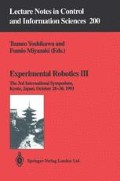Abstract
The combination of recent improvements in robotic tactile sensors and the development of new neural network paradigms and tools currently allows to investigate of tactile perception problems in robotics by mimicking last findings in neurophysiology. In this paper we describe an antropomorhic approach to robotic tactile perception, which is characterized by a strong biological inspiration both in the hardware tools and in the processing methodologies. As a first step toward this goal, an antropomorphic robotic finger including three different kinds of tactile receptors (static, dynamic and thermal) has been designed and fabricated, and the problem of sensory-motor control for feature enhancement micro-movements has been investigated. A neural network architecture is proposed for what we believe to be the basic problem of tactile perception, that is the autonomous learning of sensory-motor coordination. Experiments are described, system performances are analyzed and possible applications are outlined.
Preview
Unable to display preview. Download preview PDF.
References
R. S. Fearing and J.M. Hollerbach “Basic solid mechanics for tactile sensing”, Int. J. Robotics Research, 4, (3):40–54, 1985.
P. Dario and G. Buttazzo, “An anthropomorphic robot finger for investigating artificial aactile perception”, Int. J. Robotics Research, 6, (3):25–48, 1987.
R. Howe, N. Popp, P. Akella, I. Kao, M. Cutkosky, “Grasping, manipulation and control with tactile sensing”, Proc. IEEE Conf. on Robotics and Automation, Cincinnati, 1258–1263, 1990.
I. Amato “In search of the human touch”, Science, 258: 1436–1437, 1992.
Y. C. Pati, P. S. Krishnaprasad, M. C. Peckerar “An analog neural network solution to the problem of early taction”, IEEE Trans. on Robotics and Automation, 8, (2):196–212, 1992.
M. Bertero, T. Poggio and V. Torre, “Ill-posed problems in early vision”, Proc. of the IEEE 76, 869–889, 1988.
A. N. Tikhonov and V. Y. Arsenin, Solution of Ill-Posed Problems, Winston and Wiley, Washington DC, 1977.
J. Aloinomos, I. Weiss and A. Bandopadhay, “Active vision”, Int. J. Comput. Vision 2, 333–345, 1988.
D. Marr, Vision, Freeman & C., New York, 1982.
J. R. Phillips, K. O. Johnson and S. S. Hsiao “Spatial pattern representation and transformation in monkey somatosensory cortex”, Proc. Natl. Acad. Sci. USA, 85, 1317–1321, 1988.
K. O. Johnson and S. S. Hsiao “Neural mechanisms of tactual form and texture perception”, Annu. Rev. Neurosci. 15, 227–50, 1992.
M. Rucci and P. Dario “Active exploration procedures in robotic tactile perception”, Workshop on Intelligent Robotic Systems, Zakopane, July 1993.
M. Rucci and P. Dario “Active exploration of objects by sensorimotor control procedures and tactile feature enhancement based on neural networks”, Proc. Int. Conf. on Advanced Mechatronics, Tokyo, 445–450, 1993.
Force Sensing Resistor, Interlink Inc., Santa Barbara, California.
R. Bajcsy, “What could be learned from one-finger experiments”, Int. Sym. Robotics Research, 509–527, 1983.
A. Hein, “Prerequisite for development of visually guided reaching in the kitten”, Brain Research 71, 259–263, 1974.
J. Piaget The grasp of consciousness: action and concept in the young child, Cambridge, MA, Harvard University Press, 1976.
M. Kuperstein, “Adaptive visual-motor coordination in multi-joint robots using parallel architecture”, Proc. IEEE Conf. on Robotics and Automation, 1595–1602, Raleigh, 1987.
M. Kuperstein, “INFANT neural controller for adaptive sensory-motor coordination”, Neural Networks 4, 131–145, 1991.
P. Gaudiano and S. Grossberg, “Vector associative maps: unsupervised real-time error-based learning and control of movement trajectories”, Neural Networks 4, 147–183, 1991.
Author information
Authors and Affiliations
Editor information
Rights and permissions
Copyright information
© 1994 Springer-Verlag London Limited
About this paper
Cite this paper
Dario, P., Rucci, M. (1994). A neural network-based robotic system implementing recent biological theories on tactile perception. In: Yoshikawa, T., Miyazaki, F. (eds) Experimental Robotics III. Lecture Notes in Control and Information Sciences, vol 200. Springer, Berlin, Heidelberg. https://doi.org/10.1007/BFb0027598
Download citation
DOI: https://doi.org/10.1007/BFb0027598
Published:
Publisher Name: Springer, Berlin, Heidelberg
Print ISBN: 978-3-540-19905-2
Online ISBN: 978-3-540-39355-9
eBook Packages: Springer Book Archive

